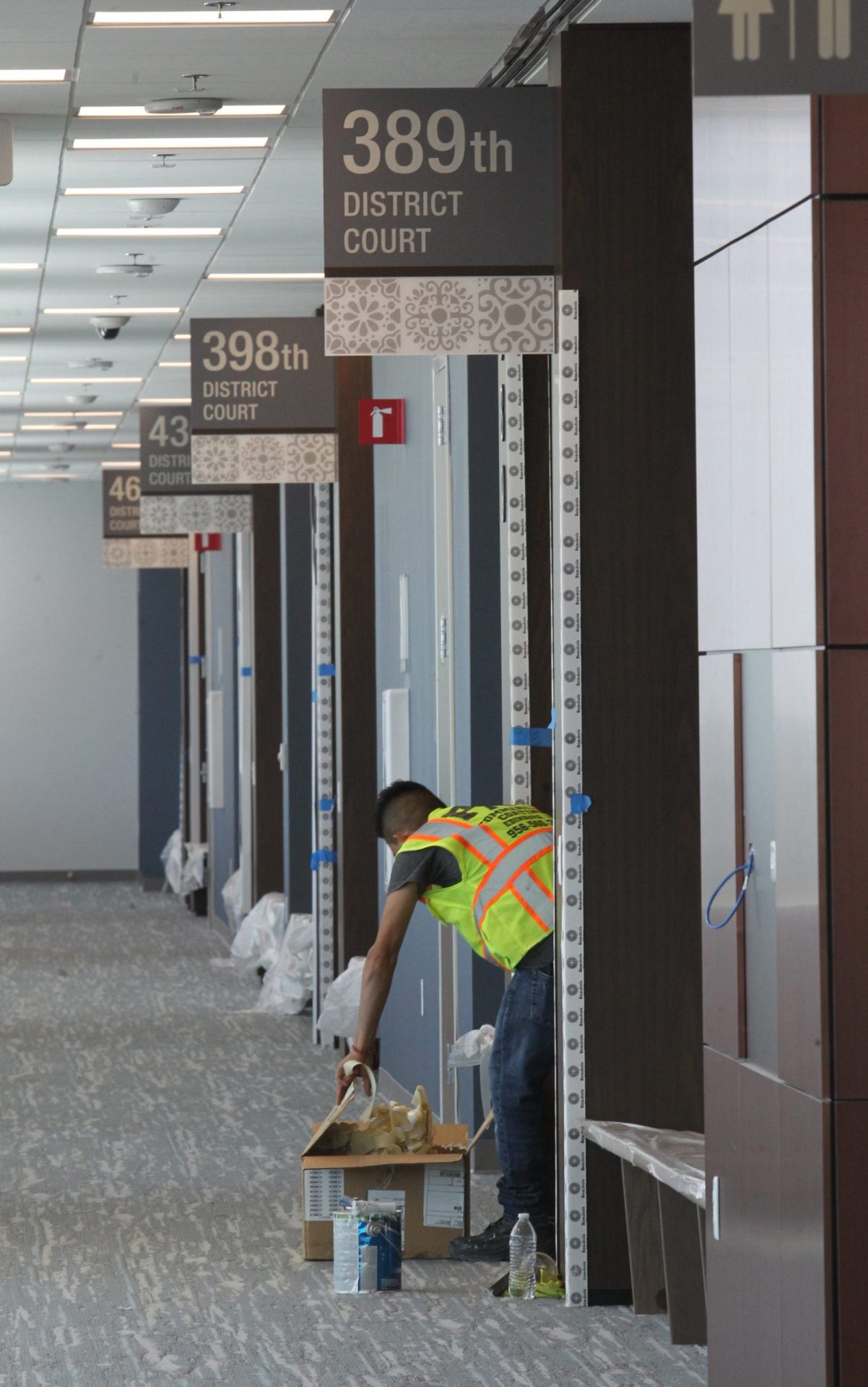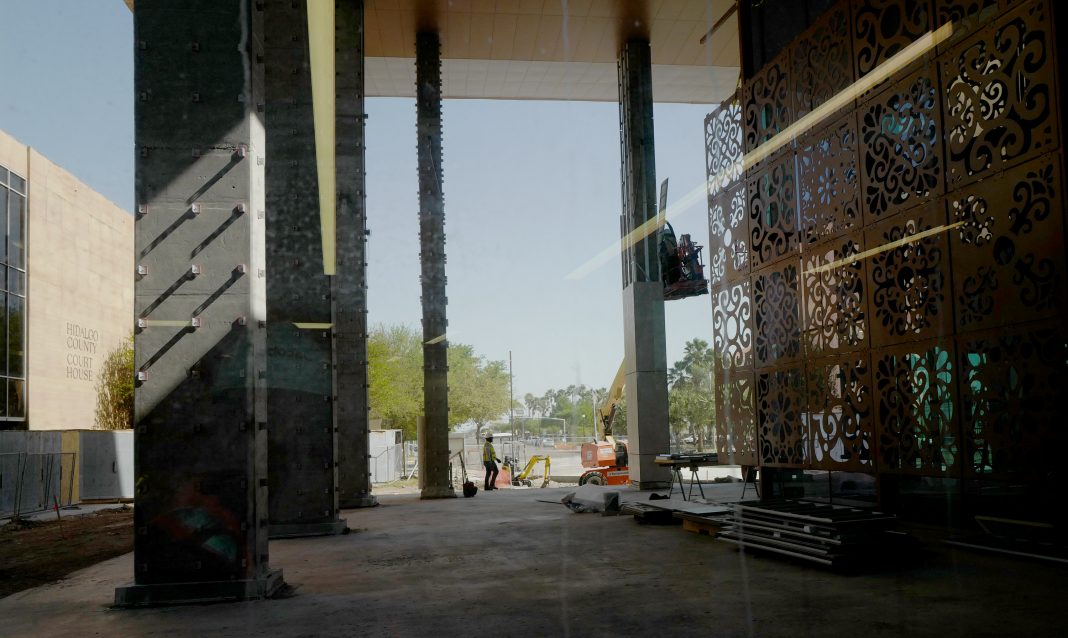EDINBURG — Natural light floods through windows that stretch across the north side of the seventh floor of the new Hidalgo County Courthouse.
Sunlight lights up the floor, illuminating a hallway where six state district courtrooms are being finalized for court staff to move into in mid-July.
If you look north through the windows in the middle of that hallway, the top of a large Hidalgo County seal on the outside of the building lines up with Closner Boulevard, inviting a sprawling bird’s-eye view of the Rio Grande Valley that’s dotted with palm trees and provides a perspective of north Edinburg and Hidalgo County that can only be compared to a final descent from an airplane.
Travel seven stories below to the first floor and an estimated five months into the future, residents with business in the new courthouse will walk through the front door of the new courthouse and into a lobby that reflects features of an airport terminal.
Once passing through security, people will see a series of mounted screens with scrolling information about court dockets and how to find courtrooms, much like finding a gate after passing through security at an airport.
The Monitor toured the new courthouse, which is more than three times the size of the old one, last week as it inches toward completion about four years after Hidalgo County broke ground on the project.
The newspaper also conducted a candid interview with Hidalgo County Judge Richard F. Cortez concerning unforeseen bumps in the project’s completion that have extended its finalization, and about the associated increased costs that pushed the final estimated cost from $150 million to somewhere between $183 and $185 million.
In that interview, Cortez said the initial public estimate of $150 million first went up when the city of Edinburg backed away from providing $30 million to improve pervasive drainage problems in the flood-prone old city square.
The judge explained that there was no legal document drafted for that pledge, which was included in the initial estimate and the county then had to cover.

As construction continued, the state mandated that Hidalgo County – the eighth largest in the state – add a new county court-at-law and a new state district court to meet the needs of a growing population, which tacked on another $14 million.
The initial estimate also didn’t include furniture and fixtures, which could be seen last week boxed and staged throughout the new courthouse as construction crews continue working toward substantial completion.
That milestone is estimated to happen May 31, according to Oscar Garcia, the project manager with Jacobs Project Management Co., the engineering group overseeing the project.
The furniture and fixtures totaled another $10 million.
Then natural calamities like Hurricane Hanna and the February freeze in 2021 impacted the building schedule, and perhaps most significantly, the pandemic, which no one could have imagined at the start of the project, sent the world into a spin.
“The combination of all that and a little bit having to do with supply chain issues pushed the date, and also because of COVID we found ourselves saying, ‘Hey, wait a minute, we need to retrofit the courthouse to be able to now accommodate all the protocols necessary to have in position to fight this COVID stuff,” Cortez said.
Those upgrades increased the cost by about $4.5 million and included doors that open automatically, as well as technology for courts to be able to operate in the infant world of hybrid court hearings, where videoconferencing is now used for certain types of proceedings.
“For that to happen we need to put in IT networking throughout the courthouse — that’s going to take a month or more. And again, we decided to add some additional stuff in there to make it ready for us to deal with this COVID situation, this pandemic preparedness,” Cortez said.
That process was evident last week. When The Monitor toured the courthouse, workers with an IT specialty were actively setting up networking in the courtrooms.
The scope of that technology was also on display, with large screens mounted in courtrooms for the public and the jury, in addition to a slew of other gadgets that will be utilized by court staff, judges and attorneys.
But that’s only one aspect of the technology now used in pandemic preparedness.
For instance, Garcia, the project manager, showed the newspaper where eight elevators meet in the middle of the first floor.
Instead of just picking an elevator to find your floor, there will be a monitor by the elevators that will tell people which elevator they should take to reach the courtroom they need to go to, rather than having people use each elevator to travel to whichever courtroom is their destination.
The idea, Garcia said, is to streamline the movement of people throughout the courthouse and to limit the surfaces that need to be touched.
Pandemic-related additions also include touchless faucets and other similar features throughout the courthouse.
Garcia said those upgrades were funded through the America Rescue Plan Act, a $1.9 trillion federal stimulus bill signed by President Joe Biden in 2021 that aimed to bolster public health and economic recovery from the pandemic.
The coronavirus, increased costs and delayed completion aside, the tour last week of the courthouse made one point evident: The days of the old courthouse that dates back to the 1950s are nearing an end.

Gone will be the days of dozens of shackled people accused of crimes being ushered through hallways in the courthouse to sit on the public benches in courtrooms to wait for their hearings.
Now, there is a day jail on the first floor of the new courthouse that connects to shared holding cells between courtrooms via elevators that can hold a total of 750 people.
The days of courtrooms packed to fire code capacity and crowded hallways are also likely nearing an end as the new courtrooms are larger, and because of the increased use of technology for hybrid hearings.
Paper dockets posted outside of courtrooms to bulletin boards with thumb tacks are also ending as now they will be displayed digitally on screens outside the courtroom doors.
The sight of attorneys lining up early in the morning before judges for their clients’ hearings may also be coming to an end. Now each courtroom has rooms for lawyers to discuss cases and the new jail is equipped with secure rooms for attorneys and clients to meet before hearings.
As for the long lines at security that were the hallmark of early mornings at the old courthouse, Garcia, the project manager, said the new courthouse’s airport-terminal design, coupled with new technology, is designed to better increase the flow of people into and throughout the courthouse.
Combine that with hybrid hearings, and court and business at the new courthouse enters a new era.
But it came with a cost.
“The people should know and understand that county governments are designed by the state of Texas to provide certain services to the population and one of those services is the judicial system,” Cortez said.
And it’s not a choice. The county can’t just decide not to provide this service, he said, which comes with the obligation to provide the necessary funding for it to operate.
“And as we keep growing, the amount of money that it takes continues to grow and that’s where we find ourselves today with this size of investment,” Cortez said.
There’s another aspect that will forever be a part of the new courthouse: the pandemic.
The impact of this event subtly and prevalently pervades the new seven-story building, which will also commemorate the terrible loss that the pandemic brought with a memorial park on the northeastern side of the property.
Officials estimate the building will be open to the public and operating in September.




